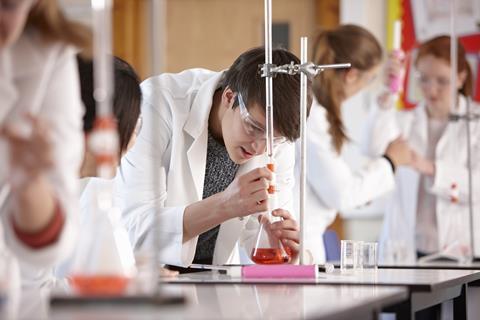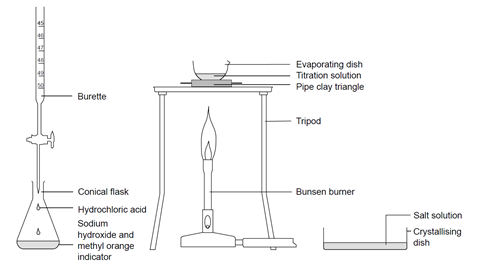Hydrochloric Acid Sodium Hydroxide Reaction
In this experiment students neutralise sodium hydroxide with muriatic acid to produce the soluble common salt sodium chloride in solution. They so concentrate the solution and allow it to crystallise to produce sodium chloride crystals
You have to determine if this experiment is suitable to use with different classes, and expect at the need for preliminary training in using techniques involved in titration (encounter Didactics notes). What follows here assumes that teachers accept judged the course to be capable of doing this experiment using a burette with reasonable expectation of success.
Assuming that the students have been given training, the practical piece of work should, if possible, start with the appliance ready at each work place in the laboratory. This is to avoid vulnerable and expensive glassware (the burette) being collected from an overcrowded central location.

Fourth dimension required
Phase 1
Filling the burette, measuring out the alkali into the flask, and titrating it until information technology is neutralised takes about 20 minutes, with false starts being likely for many groups. In exercise it does not matter if the end-signal is overshot, even by several cubic centimetres, but the aim is to find the proportions for a roughly neutral solution.
Stage 2
Producing a neutral solution free of indicator, should take no more than 10 minutes.
Stage three
Evaporating the solution may take the residuum of the lesson to the signal at which the solution can be left to crystallise for the side by side lesson. Watching solutions evaporate tin can be boring for students, and they may need another job to continue them occupied – eg rinsing and draining the burettes with purified h2o.
Equipment
Apparatus
- Eye protection
- Burette, thirty or fifty cm3 (notation one)
- Conical flask, 100 cm3
- Beaker, 100 cm3
- Pipette, twenty or 25 cmthree, with pipette filter
- Stirring rod
- Minor (filter) funnel, about four cm diameter
- Burette stand and clench (annotation two)
- White tile (optional; note 3)
- Bunsen burner
- Tripod
- Pipeclay triangle (note 4)
- Evaporating basin, at to the lowest degree 50 cm3 chapters
- Crystallising dish (note v)
- Microscope or hand lens suitable for examining crystals in the crystallising dish
Appliance notes
- If your schoolhouse still uses burettes with drinking glass stopcocks, consult the CLEAPSS Laboratory Handbook, department 10.10.1, for their care and maintenance. This experiment volition not be successful if the burettes used have stiff, blocked or leaky stopcocks. Mod burettes with PTFE stopcocks are much easier to use, crave no greasing, and do not get blocked. Burettes with pinchcocks of any blazon are not recommended; while cheap, they too are prone to leakage, peculiarly in the hands of student beginners.
- Burette stands and clamps are designed to prevent crushing of the burette by over-tightening, which may happen if standard jaw clamps are used.
- The optional white tile is to get under the titration flask, but white paper can be used instead.
- Ceramic gauzes tin can be used instead of pipeclay triangles, but the evaporation then takes longer.
- The evaporation and crystallisation stages may be incomplete in the lesson time. The crystallisation dishes need to be set up aside for crystallisation to have place slowly. However, the dishes should not be allowed to dry completely, as this spoils the quality of the crystals. With occasional checks, it should be possible to decide when to decant surplus solution from each dish to leave skillful crystals for the students to audit in the post-obit.
Chemicals
- Sodium hydroxide solution, 0.iv Grand (IRRITANT), about 100 cmthree in a labelled and stoppered bottle
- Dilute hydrochloric acid, 0.iv M, most 100 cm3 in a labelled and stoppered bottle
- Methyl orange indicator solution (or alternative) in small dropper bottle
Wellness, rubber and technical notes
- Read our standard health and prophylactic guidance.
- Wearable heart protection throughout.
- Sodium hydroxide solution, NaOH(aq), (IRRITANT at concentration used) – see CLEAPSS Hazcard HC091a and CLEAPSS Recipe Volume RB085. The concentration of the solution does not need to exist made up to a high degree of accurateness, but should exist reasonably shut to the same concentration every bit the dilute hydrochloric acid, and less than 0.v M.
- Dilute hydrochloric acid, HCl(aq) – see CLEAPSS Hazcard HC047a and CLEAPSS Recipe Book RB043. The concentration of the solution does not demand to be made up to a high degree of accuracy, but should be reasonably close to the same concentration every bit the sodium hydroxide solution, and less than 0.five Thousand.
- Methyl orange indicator solution (the solid is TOXIC merely not the solution) – see CLEAPSS Hazcard HC032 and CLEAPSS Recipe Book RB000.
Procedure

Stage 1
- Using a minor funnel, pour a few cubic centimetres of 0.4 M muriatic acid into the burette, with the tap open up and a beaker under the open up tap. Once the tip of the burette is total of solution, close the tap and add more solution upwards to the zippo mark. (Do not reuse the acid in the chalice – this should be rinsed downwardly the sink.)
- Utilize a pipette with pipette filler to transfer 25 (or 20) cmthree of 0.iv Yard sodium hydroxide solution to the conical flask, and add together ii drops of methyl orange indicator. Swirl gently to mix. Place the flask on a white tile or piece of clean white paper under the burette tap.
- Add the hydrochloric acid to the sodium hydroxide solution in small volumes, swirling gently later each addition. Keep until the solution just turns from yellow-orange to red and record the reading on the burette at this point. This coloured solution should at present be rinsed downwardly the sink.
Phase ii
- Refill the burette to the zero marking. Carefully add the same volume of fresh hydrochloric acrid as you used in stage 1, step 3, to another 25 (or 20) cm3 of sodium hydroxide solution, to produce a neutral solution, but this time without any indicator.
Phase iii
- Pour this solution into an evaporating bowl. Reduce the volume of the solution to about one-half by heating on a pipeclay triangle or ceramic gauze over a low to medium Bunsen burner flame. The solution spits virtually the end and you go fewer crystals. Practice not eddy dry out. You may need to evaporate the solution in, say, 20 cm3 portions to avoid overfilling the evaporating basin. Do not attempt to lift the hot basin off the tripod – let to cool first, so cascade into a crystallising dish.
- Exit the concentrated solution to evaporate further in the crystallising dish. This should produce a white crystalline solid in 1 or ii days.
- Examine the crystals under a microscope.
Looking for an alternative method?
Check out our applied video on preparing a salt for a safer method for evaporating the solution, along with technician notes, instructions and a run a risk assessment action for learners.
Teaching notes
Titration using a burette, to measure volumes of solution accurately, requires careful and organised methods of working, manipulative skills centrolineal to mental concentration, and attention to detail. All of these are of course desirable traits to be developed in students, but there has to be some caste of bones competence and reliability before using a burette with a class. The experiment is nigh likely to be suited to 14–16 year erstwhile students. This is discussed farther beneath, but what follows here assumes that you accept judged the class to be capable of doing this experiment using a burette with reasonable expectation of success.
Students need training in using burettes correctly, including how to clamp them deeply and fill them safely. You should consider demonstrating burette technique, and give students the opportunity to do this. In this experiment a pipette is non necessary, as the aim is to neutralise any volume of brine is used, and that can be measured roughly using a measuring cylinder.
Information technology is not the intention hither to practise quantitative measurements leading to calculations. The aim is to introduce students to the titration technique merely to produce a neutral solution.
Alternative indicators you can utilise include screened methyl orange (greenish in alkali, violet in acid) and phenolphthalein (pink in brine, colourless in acid).
Leaving the full-bodied solutions to crystallise slowly should help to produce larger crystals. The solubility of sodium chloride does non alter much with temperature, so simply cooling the solution is unlikely to form crystals.
Under the microscope (if possible, a stereomicroscope is best) you tin see the cubic nature of the crystals. If crystallisation has occurred in shallow solution, with the crystals just partly submerged, 'hopper-shaped' crystals may be seen. In these crystals, each cube face becomes a hollow, stepped pyramid shape.
Student questions
Stage one
What substances have been formed in this reaction? Write a give-and-take equation and a symbol equation.
Stage 2
Why must y'all use another 25 cm3 of sodium hydroxide solution, rather than making your crystals from the solution in stage i?
Stage iii
What shape are the crystals?
Hydrochloric Acid Sodium Hydroxide Reaction,
Source: https://edu.rsc.org/experiments/titrating-sodium-hydroxide-with-hydrochloric-acid/697.article
Posted by: bowennack1994.blogspot.com


0 Response to "Hydrochloric Acid Sodium Hydroxide Reaction"
Post a Comment